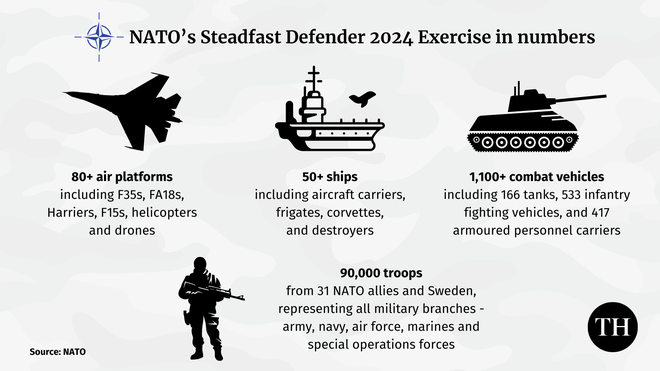The story so far: The North Atlantic Treaty Council (NATO) started its largest military exercise in Europe — the Steadfast Defender 2024 — at the end of January, which is being seen as a statement of solidarity against Russia, after two years of its invasion of Ukraine. The exercise is being conducted in two parts — the first phase began January end and will last till mid-March and focus on maritime reinforcement across the Atlantic and in the Arctic. The second phase (mid-February to end of May) will focus on using deployed reinforcements across all domains, from the Arctic to the Eastern Flank.
What is the military exercise all about?
According to NATO, the military exercise incorporates land, air, sea, cyber, and space operations to enhance civil-military cooperation. Over 90,000 troops from 31 NATO allies as well as special invitee Sweden are expected to participate in the exercise over the next few months.
During the first phase (Transatlantic reinforcement) of the exercise, North American forces are scheduled to move to Europe across the Atlantic Ocean. The phase includes live maritime exercises and amphibious assault training in the North Atlantic and Arctic Seas.
The second phase will focus on multi-domain exercises across Europe and will test the rapid deployment of troops within the NATO borders.
Why is it significant?
NATO’s Steadfast Defender 2024 is the largest exercise conducted by the alliance since the Cold War. Its main purpose is to highlight its collective military might and commitment to the security of its members, seemingly in light of Russia’s invasion of Ukraine. With a fleet of over 50 naval units alongside over 80 aircraft and more than 1,100 combat vehicles, the military exercise is a “clear demonstration of our unity, strength and determination to protect each other, our values and the rules-based international order,” American General Christopher G. Cavoli said in a statement.
While official statements have mostly reiterated that the exercise is a show of the strength and unity of NATO allies, experts believe that its main purpose is to deter Russia from expanding operations in Ukraine, and to even serve as a warning to Kremlin. European countries and the U.S. have, time and again, pledged their support to Ukraine against Russia in the form of statements of solidarity as well as financial commitments.

Earlier in February, the U.S. Senate approved a $95 billion aid package that includes funds for Ukraine (although right-wing U.S. House Speaker Mike Johnson has indicated his Republican-led chamber will reject it.) France, another founding member of NATO, has pledged $3.2 billion in military aid to Ukraine this year. Germany, on the other hand, pledged $1.2 billion package of military aid, including 36 howitzers, 120,000 rounds of artillery ammunition and two more air-defence systems, to Ukraine. Overall, the European Union and its member States (EU is an alliance of 27 member States of which 22 are in NATO), have made $148.5 billion available to Ukraine, including its recently announced support package of $54 billion, since Russia’s full-scale invasion in February 2022, the Institute for the Study of War reported. The recent round of financial assistance promised to Ukraine solidifies EU and NATO’s continuous support to the country’s efforts against Russia, which makes the Steadfast Defender 2024 exercise even more significant.
The exercise is strategically located in European countries including Finland, Estonia, Germany, Greece, Hungary, Latvia, Lithuania, Norway, Poland, Romania, Slovakia, Sweden, and the United Kingdom. . While the countries are spread across the continent, special focus has been given to those around the Baltic Sea. This is significant in relation to Russia, as Russian exclave Kaliningrad is situated between EU and NATO members Lithuania and Poland, and is also the headquarters of Russia’s Baltic Sea fleet, and the country’s only ice-free European port. According to the Centre for Research on Energy and Clean Air, around 57% (by volume) of Russia’s total oil exports were shipped from the Russian Baltic Sea port in September 2023.
EU countries like Estonia, Latvia, Lithuania, and Poland, which are geographically closer to Russia, also act as bases for NATO’s Enhanced Forward Presence (EFP) – multinational battalion-size troops led by the U.K., Canada, Germany, and the U.S.
Alongside traditional theatreslike land, air, and sea, this military exercise will also incorporate cyber and space operations, making it more relevant to the present. By training together as against training at a national level, NATO member states seek to strengthen their ability to collaborate in real-world operations.







